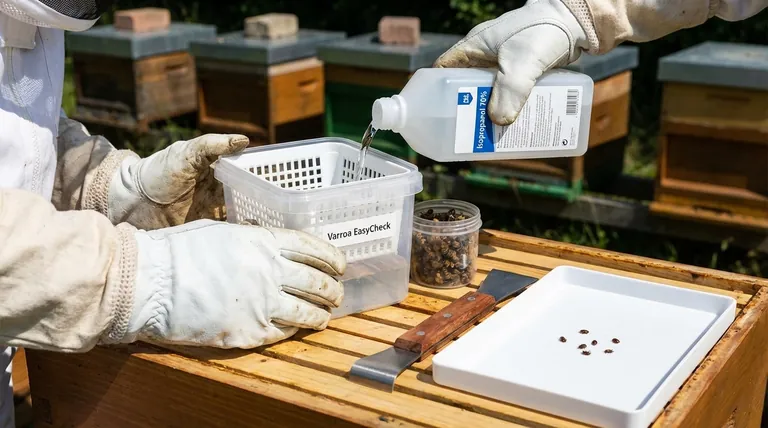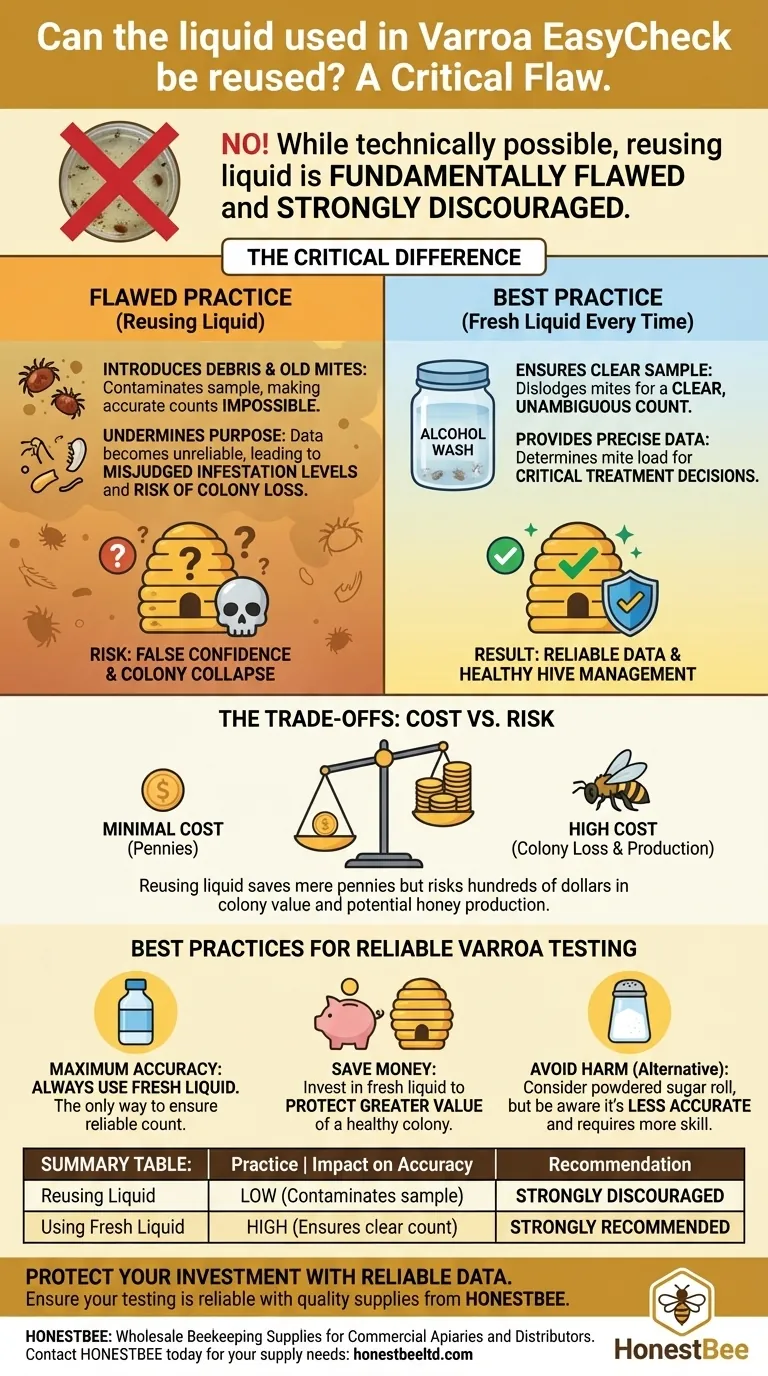Yes, while the liquid in a Varroa EasyCheck can technically be reused, this practice is fundamentally flawed and strongly discouraged. Reusing the liquid introduces debris and old mites from the previous sample, making an accurate count on a new sample impossible. This directly undermines the entire purpose of mite testing, which is to get precise data to make critical decisions about colony health.
The goal of Varroa monitoring is to achieve an accurate mite count. Reusing liquid contaminates your sample with old mites and debris, leading to unreliable data that can cause you to misjudge your hive's infestation level and risk colony loss.

Why Accuracy is Non-Negotiable in Mite Monitoring
The Varroa mite is the single greatest threat to honey bee health. Effective management relies entirely on accurate and timely data about the infestation level within your hives.
The Purpose of a Mite Wash
An alcohol wash, the method used with the Varroa EasyCheck, is considered the gold standard for mite monitoring for one reason: accuracy.
The process is designed to dislodge every mite from a sample of bees and allow for a clear, unambiguous count. This precise number tells you the mite load per 100 bees, which you then compare against established treatment thresholds.
Decisions Based on Data
Your decision to treat a colony—or not—is a direct result of your mite count. An artificially low count (from an obscured sample) can give you a false sense of security, leading you to withhold necessary treatment and potentially lose the entire colony.
The Critical Flaws of Reusing Mite Wash Liquid
Saving a few cents on alcohol is not worth the risk of compromising your data. Reusing the liquid creates immediate and significant problems.
Contamination and Debris
After the first wash, the liquid is no longer clear. It is contaminated with dead bees, bee parts, and, most importantly, the very mites you just counted.
The Impossibility of an Accurate Count
When you add a new bee sample to this used liquid, it becomes impossible to distinguish the new mites from the old ones. You cannot be certain which mites belong to which sample, making your count nothing more than a guess.
The Risk of False Confidence
An inaccurate mite count is worse than no count at all. If you undercount your mites because of a contaminated sample, you will fail to act when your colony is in danger. This can lead to a sudden colony collapse or the creation of a "mite bomb" that infects other hives in your apiary.
Understanding the Trade-offs
The choice to reuse liquid is a trade-off between a tiny cost saving and the health of your entire beekeeping operation.
The Minimal Cost of Fresh Liquid
The most common liquid for a mite wash is inexpensive winter windshield washer fluid (with an alcohol base and no detergents) or diluted rubbing alcohol. The cost for a single, fresh test is mere pennies.
The High Cost of Inaccurate Data
A single honey bee colony is worth hundreds of dollars in equipment, bees, and potential honey production. Losing that colony because you relied on flawed data from a reused sample is a significant and easily avoidable financial loss.
A Simple Analogy
Think of it like a medical lab test. You would never expect a lab to reuse a test tube or needle from a previous patient to analyze your blood sample. The risk of cross-contamination makes the results meaningless. The same principle applies directly to Varroa mite testing.
Best Practices for Reliable Varroa Testing
To get data you can trust, follow the proven best practices used by professional and successful hobbyist beekeepers.
- If your primary focus is maximum accuracy: Always use a fresh alcohol wash with new, clean liquid for every single sample. This is the only way to ensure your count is reliable.
- If your primary focus is saving money: Recognize that the negligible cost of fresh liquid is an essential investment in protecting the far greater value of a healthy colony.
- If your primary focus is avoiding harm to bees: Consider a powdered sugar roll, but be aware that it is less accurate than an alcohol wash and requires more skill to perform correctly. The principle remains the same: you must use fresh powdered sugar for each test.
Ultimately, using fresh liquid for every test is the only way to generate the reliable data you need to protect your bees effectively.
Summary Table:
| Practice | Impact on Accuracy | Recommendation |
|---|---|---|
| Reusing Liquid | Low - Contaminates sample with old mites/debris | Strongly Discouraged |
| Using Fresh Liquid | High - Ensures a clear, unambiguous count | Strongly Recommended |
Protect Your Investment with Reliable Data
Your beekeeping operation depends on accurate mite counts to make critical treatment decisions. Don't risk colony loss over pennies worth of liquid. Ensure your testing is reliable with quality supplies from HONESTBEE.
HONESTBEE supplies beekeeping supplies and equipment to commercial apiaries and beekeeping equipment distributors through wholesale-focused operations. We provide the tools you need for effective hive management.
Contact HONESTBEE today to discuss your supply needs and ensure the health of your apiary.
Visual Guide

Related Products
- Professional Dual-End Stainless Steel Hive Tool for Beekeeping
- HONESTBEE Professional Mini J-Hook Hive Tool for Beekeeping
- Professional Multi-Function Stainless Steel Hive Tool
- Multi-Function Plier-Style Frame Grip Hive Tool
- Professional Stainless Steel Pry-Bar Hive Tool
People Also Ask
- What is a hive tool used for in beekeeping? Your Essential Guide to Hive Management
- What should beginners consider when purchasing beekeeping equipment? A Guide to Essential Starter Gear
- What temperature is too cold to open a beehive? Protect Your Hive from Fatal Cold Shock
- What is a hive tool and what are its uses? Master Your Hive Inspections with the Essential Beekeeper's Tool
- What are the basic tools for beekeeping? Essential Starter Kit for Safe & Successful Hive Management



















